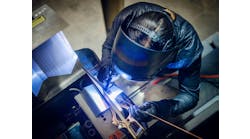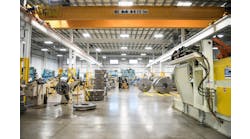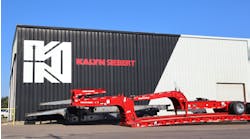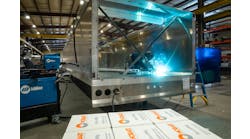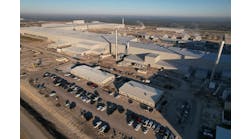Compared to other stainless steels, 2205 is stronger, more resistant to pitting, supporters say
Wabash National vice president John Cannon is a fan of using 2205 duplex stainless steel in the production of tank trailers.
He’s seen the benefits outside and in.
During the presentation “2205 Stainless Steel in the Real Tank World” at Tank Truck Week 2019 in Nashville, Tennessee, Cannon told the story of climbing into a duplex steel tank that was in a rollover accident while filled with $100,000 worth of flammable product—and still looked nearly brand new inside.
According to the carrier hauling the load and the resulting accident report, the trailer rolled 50 feet down an embankment, taking out several trees along the way, but the 12-gauge shell did not leak or puncture, and the barrel remained fully salvageable and repairable, with no “cupping” at the rings that were impacted.
“This carrier, just based on what they have ordered since this incident, is a believer in duplex,” he assured the audience.
Cannon’s goal was to make everyone in the room a fervent believer, too.
He and Chris Kern, the lease fleet manager at Huntsville, Texas-based tank trailer dealer The Jack Olsta Company, talked about the history of 2205, its unique chemical makeup, and the many benefits of using duplex steel in tank construction, including increased strength, and resistance to corrosive pitting and thermal shock.
“Our hope is to be able to (discuss) with you some of the experiences I know you have had, and that have impacted you just as they have me, and the success that we’ve experienced as we’ve made some changes,” Kern said.
2205 history
2205, which is duplex steel, meaning it’s a combination of ferritic and austenitic steel, is not a new or experimental metal.
The earliest version was developed in Europe in the 1930s, Cannon said. New, more weldable duplex alloys, like 2205 SS, were introduced in the 1950s, and the first “significant” deployment of duplex came in the 1990s in Sentinel Transportation’s tank trailer fleet, under the direction of then-equipment manager Orville White.
“These duplexes were created and intended to be seawater-resistant, and we all know what’s in seawater, of course, from a corrosion standpoint,” Cannon said.
The metal’s corrosion resistance is the primary driver beyond its adoption today.
Corrosion’s been a major issue for the tank trailer industry for decades. In 2002, NACE International and the Federal Highway Administration conducted a study that found the industry was spending more than $900 million a year repairing damage caused by corrosion, with most of that cost related to pitting inside tanks.
More recently, in steering committee discussions in which Cannon participated, several carriers reported annual expenses due to corrosion in excess of $300,000 annually, and one carrier reported losing $800,000 in one year.
And the challenges that make corrosion an industry issue still persist.
For example, shippers often offer chemical loads with proprietary blends, making it difficult for carriers to ascertain exactly what is in the product. Sometimes the chemical information is incomplete, or the constituents don’t equal 100%, and the missing ingredient isn’t only water. And some chemical manufacturers will even change the product formula from one year to the next without updating the safety data sheet.
Now the product features a new chemical, like a chloride, that ruins stainless steel tanks, and the carrier has no idea.
“Our industry has a big challenge, and Chris and I would like to suggest that 2205 can go a long way toward addressing that challenge,” Cannon said.
Chemical composition
Adoption of duplex grew in the 2000s as the price of 407 steel doubled, largely because of the increasing cost of nickel, and the supply of domestic steel began increasing in the 2010s as larger North American mills began producing the metal in greater quantities, helping reduce the cost of the stronger, more tensile material.
By 2019, 2205 had replaced T316 as the most commonly sourced alloy in any given month, Cannon said, so it’s already gaining acceptance.
The elements that matter most in 2205 are chromium and molybdenum, which appear in higher concentrations than in 316, providing superior resistance to pitting from corrosion. “Chromium is so important as to the formation of the passive film within the stainless steel tank, so the more chromium that’s present … in the presence of oxygen, the more chromium oxide that will form, and a more robust chromium oxide layer or passive layer,” Cannon explained. “That is a carrier’s first line of defense against a corrosive attack.
“So chromium is really a good thing, and it’s not nearly as expensive as nickel.”
The alloy metal’s makeup also gives it greater yield and tensile strength, and superior resistance to super-heated products, reducing the risk of thermal shock. The yield strength is 2½ times greater than that of 316 stainless steel, Cannon said, and the tensile strength is 30% greater, so many manufacturers receive special DOT permitting to build 2205 barrels thinner, which has the added benefit of reducing weight.
“Duplex steels are virtually immune (to damage), and with all of the hot-product tanks we’ve made out of 2205, at this point I’m not aware of a single episode of thermal shock or buckling of the tank,” Cannon said.
Real-world benefits
Kern said the benefits of using 2205 duplex steel in tank construction aren’t theoretical. They’re real, and they’re many.
Perhaps the most important is customer satisfaction.
With a 45% increase in pitting resistance in the 2205 trailers in their fleet, The Jack Olsta Company can offer customers greater assurances against a variety of products, which, in turn, improves the lessee-lessor relationship. “As a lessor, my job is to have an asset that lasts a long time,” Kern said. “I want to be able to provide a revenue on that piece of equipment, that asset, and 10% of its shelf life doesn’t do that very well.”
Another benefit of 2205 is greater corrosion allowance, or the amount of material that can be lost to corrosion before the tank is compromised, extending the life of the equipment. A trailer made with 316 steel at a thickness of .125 inches can degrade to .115 inches, Kern said, while a 2205 tank with the same starting thickness can wear down to .098 inches, with a special permit, adding up to 17 mils of resistance.
“So on a 20-year asset, you’ve got 10 thousandths (mils),” Kern said. “With that special permit, I’ve got an additional 17 thousandths. If I equate that, and use the same formula that I figured .0005 (thousandths of corrosion available to be lost) per year, I’ve now got an asset that can last 54 years. That’s significant.”
Kern said his company has purchased 160 2205 trailers over the last several years and, in their experience, they are stronger, tougher—and up to 700 pounds lighter through the use of 12-gauge metal, as opposed to 10-gauge 316. The weight savings isn’t as important to Jack Olsta, but it is to their customers.
And with improved heat resistance, carriers can load products at 400 degrees Fahrenheit and higher without fear of thermal shock, and the resulting barrel deformation.
“Those are some of the benefits that we have experienced in our fleet today, and have helped us improve revenue as our trailers are not in the shop as often, having pit repair, and down as long,” Kern said. “They’re able to be out with the customers, and earning revenue for them and us at the same time.”
Obstacles overcome
When considering adding 2205 trailers to his fleet, Kern looked at several potential obstacles, including increased pricing, the need for special permitting, the darker barrel finish, and the ability to find qualified repair shops.
These obstacles all weren’t easily overcome, Kern admitted, but the benefits outbalanced the bother.
Duplex metals require more labor to manufacture, they’re more painstaking to repair, and the gas mixtures in the weld are different. But shops are more familiar with 2205 now than they were only a few years ago, and more manufacturers are able to help walk shop managers through the process, and the training required.
“Overall, it was just an education, and people getting used to something different in regard to the process, the gas mixture and how to repair or weld those pits,” Kern said.
The darker finish is due to 2205’s unique chemical makeup, which doesn’t provide the same polished look of 316’s mirror-like surface. 2205 is duller, and Kern said when he first saw a 2205 tank, he thought something might be wrong with it, and that his customers wouldn’t approve. But, again, education overcame the obstacle.
As for the premium price, savings in pit repairs help mitigate the smaller margins in equipment purchases, and with the rising cost of nickel, and increased production of duplex, the cost of 2205 is decreasing anyway. And, yes, the special permits required are an extra hassle—and another document for drivers to carry around—but Jack Olsta handles renewals, reducing the burden on their carrier customers.
“The things that we were concerned about easily were insignificant compared to the benefits that we gained,” Kern attested.
The Jack Olsta Company is adding more 2205 trailers to its fleet every year, and so are carriers. Kern said he talked to his customers and other carriers who, combined, have had about 600 2205 trailers hauling all kinds of products over the last three to five years—and fewer than 20 experienced any pitting in that span.
“That’s remarkable,” Kern said. “That changes an organization, a company, and the outlook going forward. Again, it’s not pit proof. We always say it’s not bullet proof, but the results that we are seeing definitely get us excited.”

